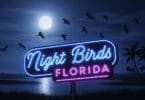Unforgettable Birds with Mohawk Marvel at These Unique Hairstyles, and many of us can’t help but be fascinated by these feathered creatures with a flair for fashion. From the iconic punk-rock hairstyle of the Crested Guan to the striking red head of the Northern Cardinal, these birds have distinct hairstyles that make them stand out.
Birds have always been admired for their beautiful plumage, but their hairstyles are just as impressive. Some birds use their feathers to create striking hairstyles, while others have curved crests that add distinction to their look. With hundreds of bird species out there, it’s difficult not to get lost in the beauty of their unique hairstyles.

Bird with Mohawk
Whether it’s the charismatic punk-rock style of the Crested Guan or the striking red mohawk of the Northern Cardinal, these unforgettable birds never fail to catch our attention. Join us as we explore the fascinating world of birds with mohawks, and discover the secrets behind these unique hairstyles.
Best Bird With Mohawk
- Northern Cardinal
- Tufted Titmouse
- Pileated Woodpecker
- Steller’s Jay
- Cedar Waxwing
- Great Crested Flycatcher
- Cockatiel
- Pyrrhuloxia
- Wood Duck
- Eurasian Hoopoe
- Victoria Crowned Pigeon
- Golden Pheasant
- Crested Tit
- Purple-crested Turaco
- Sulfur-crested Cockatoo
Northern Cardinal
The Northern Cardinal, also known as Cardinalis cardinalis, is a beautiful and striking bird that can be found throughout North America. Their vibrant red feathers make them easy to spot among the greenery of their natural habitat. These birds are predators and feed on insects, seeds, and fruits. Interestingly, the Northern Cardinal is monogamous and stays in pairs throughout the year.
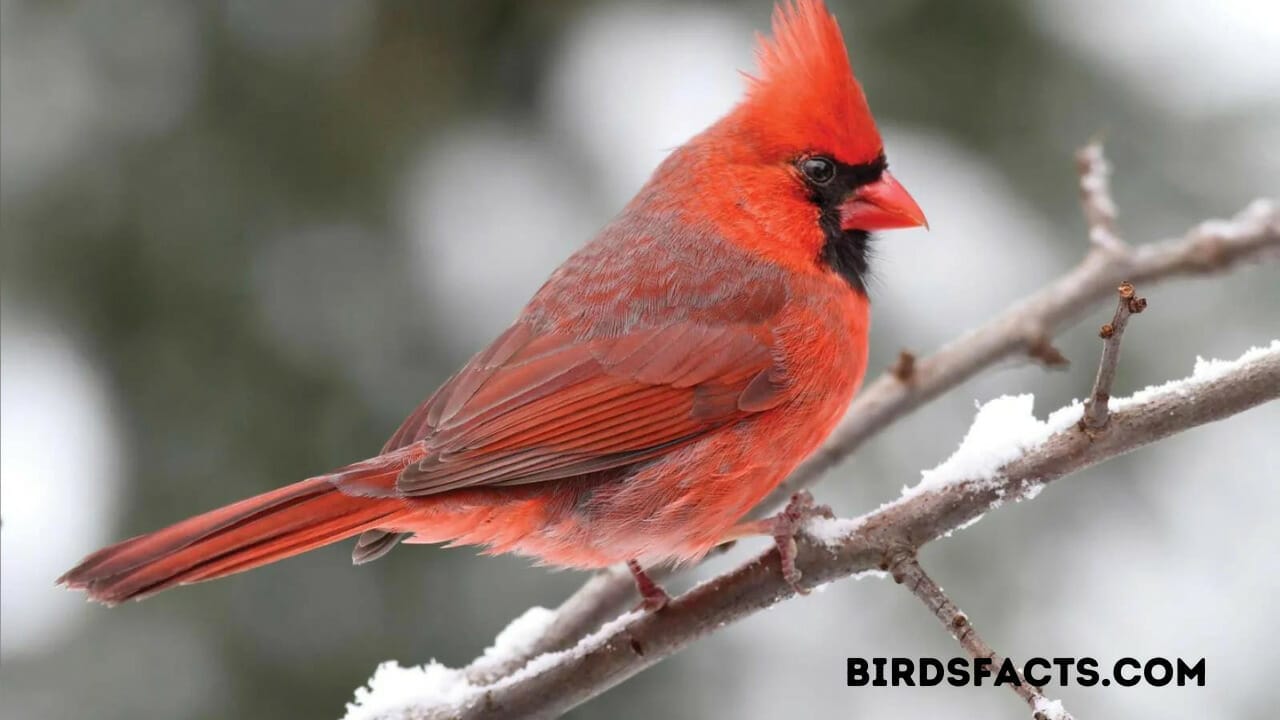
bird with a mohawk
Their estimated population is over 100 million birds, but their biggest threat is habitat loss due to human activities. One of the most distinctive features of the Northern Cardinal is the crest at the top of its head, which it can raise or lower depending on its mood. They are also known as Redbirds or Virginia Nightingales and have a wingspan of around 10 inches.
Incubation of their eggs takes around 12-13 days, and they usually nest in shrubs, bushes, or small trees. Predators of the Northern Cardinal include domestic cats, hawks, and snakes, and their diet includes seeds, fruits, spiders, insects, and snails. Northern Cardinals are a type of songbird known for their beautiful songs that can help identify their presence. They are one of North America’s most common and recognizable birds, with only one species within their family.
These birds can be found in various locations, from woodlands to suburban areas. They usually molt once a year, and their plumage changes from a duller shade of red to a brighter, vibrant hue. They have a skin type of feathers and can fly up to 28 miles per hour. In the wild, they typically live for 3-4 years and weigh around 1.6 ounces. Their length ranges from 8.3 to 9.3 inches, making them a medium-sized bird.
| Feature | Information |
|---|---|
| Common Name | Northern Cardinal |
| Scientific Name | Cardinalis cardinalis |
| Description | A beautiful and striking bird with vibrant red feathers, easy to spot in North America’s greenery. |
| Habitat | Throughout North America, from woodlands to suburban areas. |
| Diet | Predators feeding on insects, seeds, and fruits. |
| Behavior | Monogamous and stays in pairs throughout the year. |
| Population Estimate | Over 100 million birds. |
| Threats | Habitat loss due to human activities. |
| Distinctive Features | Crest at the top of its head, raise or lower depending on mood. Also known as Redbirds or Virginia Nightingales. |
| Wingspan | Approximately 10 inches. |
| Incubation Period | Around 12-13 days. |
| Nesting Habits | Nests in shrubs, bushes, or small trees. |
| Predators | Domestic cats, hawks, and snakes. |
| Diet Composition | Seeds, fruits, spiders, insects, and snails. |
| Song and Vocalization | Known for beautiful songs that can help identify their presence. |
| Family | Only one species within their family. |
| Plumage Changes | Molts once a year, changing from a duller shade of red to a brighter, vibrant hue. |
| Flight Speed | Capable of flying up to 28 miles per hour. |
| Lifespan | Typically live for 3-4 years in the wild. |
| Weight | Approximately 1.6 ounces. |
| Length | Ranges from 8.3 to 9.3 inches, making them a medium-sized bird. |
Tufted Titmouse
The Northern Cardinal, commonly known as the Cardinal, is a distinctive bird species with a bright red color native to North America. They are found all over the United States, except for the Pacific Northwest and parts of New England. Their scientific name is Cardinalis cardinalis, and they belong to the family of Cardinalidae.

bird mohawk
These birds are bigger than the Tufted Titmouse, with a wingspan of around 10.5 inches and a length of 8.5 inches. Their most distinct feature is their bright red color, which makes them easy to spot. However, only the males have this bright red plumage, while the females have more muted brownish-red feathers. Cardinals are a common sight in backyards, parks, and gardens, and they mainly feed on seeds, fruits, and insects.
Interestingly, the Cardinal is not the only bird species with a tuft on its head. The Tufted Titmouse, with the scientific name Baeolophus bicolor, is another bird with similar feathers. The Cardinal’s diet mostly consists of seeds, nuts, and fruits, but they sometimes prey on insects to supplement their diet. Their biggest threat is habitat loss due to urbanization and deforestation. As for nesting, Cardinal pairs generally choose dense shrubs or tree branches, and they usually lay three to four eggs per clutch. The incubation period is around 12-13 days, and the young birds take around two weeks to fledge. Cardinals typically live in the wild for up to 15 years, with a top speed of around 20 mph. Despite their popularity, the global estimated population size of Cardinals is around 100 million.
| Species Name | Northern Cardinal |
|---|---|
| Common Name | Cardinal |
| Native to | North America |
| Distribution | All over the United States (except Pacific NW and parts of New England) |
| Scientific Name | Cardinalis cardinalis |
| Family | Cardinalidae |
| Size | Wingspan: Approximately 10.5 inches (26.7 cm) |
| Length: Approximately 8.5 inches (21.6 cm) | |
| Plumage Color | Bright red (males), muted brownish-red (females) |
| Habitat | Backyards, parks, gardens |
| Diet | Seeds, fruits, insects |
| Tufted Titmouse | Another bird species with similar feathers |
| Scientific Name: Baeolophus bicolor | |
| Diet (Cardinal) | Seeds, nuts, fruits, occasional insects |
| Threats | Habitat loss (urbanization, deforestation) |
| Nesting | Dense shrubs or tree branches |
| Clutch Size | 3-4 eggs per clutch |
| Incubation Period | Approximately 12-13 days |
| Fledging Period | Approximately 2 weeks |
| Lifespan | Up to 15 years |
| Top Speed | Approximately 20 mph |
| Global Population | Estimated around 100 million |
Pileated Woodpecker
The Pileated woodpecker, scientific name Dryocopus pileatus, is a magnificent bird inhabiting North America’s forests, from southern Canada to the eastern United States. This woodpecker is a majestic sight to behold, with a wingspan that can reach up to 30 inches and a length of 16-19 inches, making it one of the largest woodpecker species in North America.

bird with black mohawk
One of the most distinctive features of the Pileated woodpecker is its bright red crest, which makes them easily recognizable. The bird’s habitat includes large forests and woodlands with plenty of trees for nesting and feeding, and their prey includes insects, fruit, and nuts. Interestingly, Pileated woodpeckers have been known to excavate large cavities in trees, serving as their nesting location and offering homes for other animals.
Although these birds have a lifespan of up to 9 years, their estimated population size is considered to be of least concern. The biggest threat to Pileated woodpeckers is habitat loss, leading to a declining population. Nevertheless, these birds remain majestic; many people are fortunate to spot them in the wild. If you ever get the chance to see one, remember that their age of molting has yet to be determined and that their top speed remains unknown.
| Species Name | Pileated woodpecker |
|---|---|
| Scientific Name | Dryocopus pileatus |
| Habitat | North America’s forests, from southern Canada to the eastern United States |
| Size | Wingspan: Up to 30 inches, Length: 16-19 inches |
| Distinctive Feature | Bright red crest |
| Diet | Insects, fruit, nuts |
| Nesting Behavior | Excavates large cavities in trees for nesting, providing homes for other animals |
| Lifespan | Up to 9 years |
| Population Status | Least concern |
| Threats | Habitat loss |
| Notable Information | Age of molting: Yet to be determined, Top speed: Unknown |
Steller’s Jay
Steller’s Jay, scientifically known as Cyanocitta stelleri, is a species of bird found mainly in Western North America. This bird is known to prey on insects, small mammals, and other birds. A fun fact about Steller’s Jay is that they can mimic sounds such as other birds, animals, and even machinery. The estimated population size of these birds is around 7 million individuals.
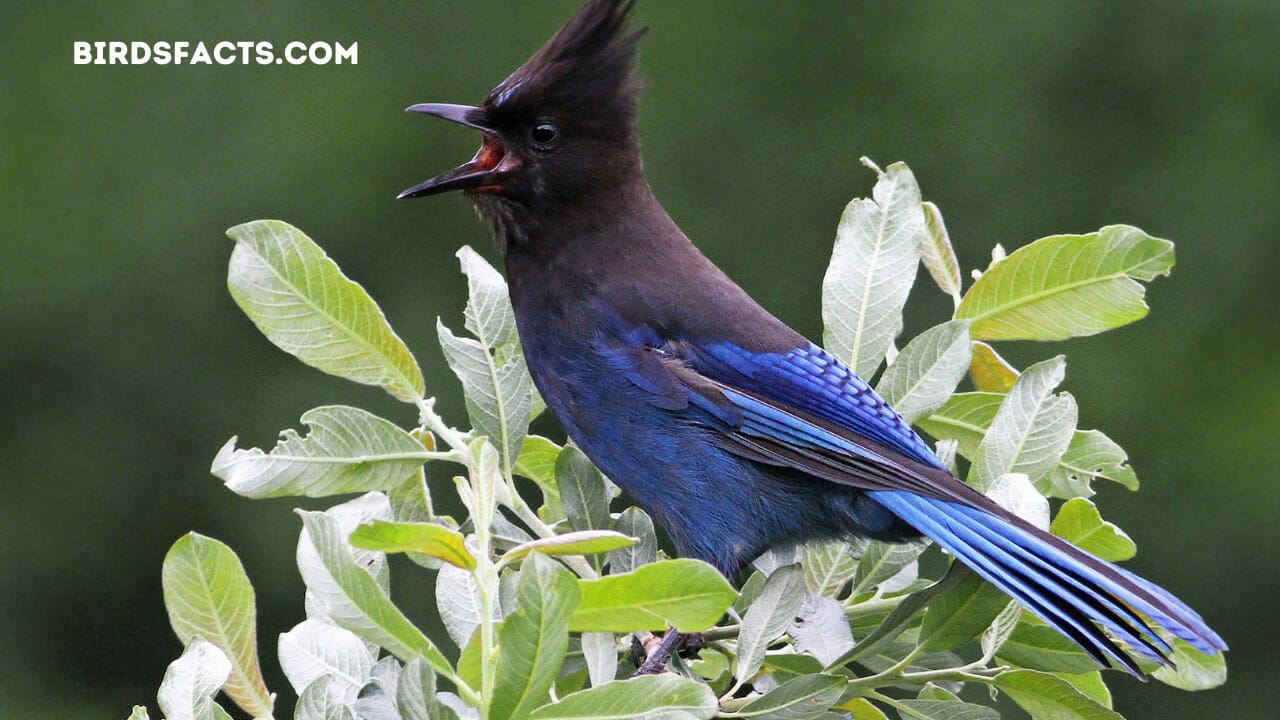
birds with mohawks
The biggest threat to Steller’s Jay is habitat loss due to deforestation. The most distinctive feature of this bird is its vibrant blue feathers with a black crest on its head. Other names for Steller’s Jay include Long-Crested Jay and Mountain Jay. The wingspan of this bird typically ranges from 15-18 inches, and incubation of the eggs takes around 16-18 days. Steller’s jays can primarily be found in coniferous forests, although they are adaptable and can survive in various habitats.
Predators of Steller’s Jay include hawks, eagles, and owls. The diet of this bird consists of insects, nuts, and seeds. Steller’s Jay is classified as a passerine bird or a perching bird. These birds can be identified by their dark blue color and black crest. Steller’s Jay is one of three species of jays in North America. The nesting location of these birds is typically in trees, where they construct nests out of sticks, moss, and other materials.
Steller’s Jay typically molts at around 1 year of age. Their skin type is feathered, and they have a top speed of around 20-25 miles per hour. The lifespan of these birds can be up to 16 years in the wild, and they typically weigh around 3-5 ounces with a length of 11-12 inches. In summary, Steller’s Jay is a beautiful and fascinating bird that has adapted well to various habitats in Western North America.
| Common Name | Steller’s Jay |
|---|---|
| Scientific Name | Cyanocitta stelleri |
| Habitat | Western North America |
| Population Size | Approximately 7 million individuals |
| Distinctive Features | Vibrant blue feathers with a black crest on the head |
| Other Names | Long-Crested Jay, Mountain Jay |
| Wingspan | 15-18 inches |
| Incubation Period | 16-18 days |
| Primary Diet | Insects, nuts, and seeds |
| Classification | Passerine bird (perching bird) |
| Predators | Hawks, eagles, and owls |
| Nesting Location | Trees |
| Molting Age | Around 1 year of age |
| Skin Type | Feathered |
| Top Speed | Approximately 20-25 miles per hour |
| Lifespan | Up to 16 years in the wild |
| Weight | 3-5 ounces |
| Length | 11-12 inches |
Steller’s Jay is a beautiful and fascinating bird found in Western North America. It has a vibrant blue color with a black crest on its head. These birds are known to mimic sounds and can adapt to various habitats. They primarily feed on insects, nuts, and seeds. The biggest threat to their population is habitat loss due to deforestation. Steller’s Jays have a wingspan of 15-18 inches and construct nests in trees using sticks, moss, and other materials. They molt at around 1 year of age and have a top speed of 20-25 miles per hour. These birds can live up to 16 years in the wild and weigh around 3-5 ounces, measuring 11-12 inches in length.
Cedar Waxwing
The Cedar Waxwing is a bird species scientifically known as Bombycilla cedrorum. These birds are known to have a special diet of fruits, especially during winter when insects are scarce. Their prey mainly consists of insects, berries, and flower nectar. A fun fact about Cedar Waxwings is that they are known to share and pass berries from one bird to another in their flock.

white bird with mohawk
These birds have an estimated population size of 65 million individuals. Their biggest threat is habitat loss due to human activities such as deforestation and urbanization. One of their most distinctive features is the red tips on their wings and silky plumage. They are also commonly known as cedar birds, cherries birds, and silk tails. The wingspan of Cedar Waxwings ranges from 11-12 inches, and their average length is between 6-7 inches.
Their incubation lasts about 12-16 days, and they typically nest in deciduous trees, conifers, or shrubs. Their predators include raptors such as the Sharp-shinned Hawk and the Cooper’s Hawk. The Cedar Waxwing is a migratory species found in North and Central America. Their molt cycle typically occurs in the first year of life and then annually thereafter.
Their colors range from brown, yellow, gray, and black, and their skin type is feathers. They can attain a top speed of 25 miles per hour and have a 5-7 years lifespan. The Cedar Waxwing’s weight ranges from 30-40 grams and it is considered a small to medium-sized bird.
| Attribute | Information |
|---|---|
| Scientific Name | Bombycilla cedrorum |
| Diet | Fruits, insects, berries, and flower nectar |
| Social Behavior | Sharing and passing berries within their flock |
| Population Size | Approximately 65 million individuals |
| Threats | Habitat loss due to deforestation and urbanization |
| Distinctive Features | Red tips on wings, silky plumage |
| Common Names | Cedar birds, cherries birds, silk tails |
| Wingspan | 11-12 inches |
| Length | 6-7 inches |
| Incubation Period | 12-16 days |
| Nesting Habits | Deciduous trees, conifers, or shrubs |
| Predators | Sharp-shinned Hawk, Cooper’s Hawk |
| Migration Range | North and Central America |
| Molting | First year of life and annually thereafter |
| Colors | Brown, yellow, gray, and black |
| Skin Type | Feathers |
| Top Speed | 25 miles per hour |
| Lifespan | 5-7 years |
| Weight | 30-40 grams |
| Size Classification | Small to medium-sized bird |
Great Crested Flycatcher
The Great Crested Flycatcher, scientifically known as Myiarchus Crinitus, is a beautiful bird species in North and Central America. This bird species feeds mainly on insects, which it captures using its sharp beak. One fun fact about the Great Crested Flycatcher is that it is known to add snakeskin to its nest, likely to deter predators. The estimated population size is around 12 million individuals, but habitat loss is the biggest threat to their population.

Great Crested Flycatcher
The most distinctive feature of this bird is its striking yellow belly and crest, which make it easy to identify. Other names for this species include the crested flycatcher or simply the flycatcher. The wingspan of the Great Crested Flycatcher can range from 12 to 15 inches, and it takes around 15 days to incubate its eggs. This bird species is often found in deciduous forests or woodlands, and its predators include snakes and raptors. Regarding diet, the Great Crested Flycatcher feeds on insects, spiders, and other small prey.
This species is classified as a type of passerine, a group of birds that includes over half of all bird species. The common name of this bird is the Great Crested Flycatcher, and there are only two species in the Myiarchus genus. The Great Crested Flycatcher can be found in the eastern United States, Mexico, and Central America. They build their nests in cavities, including woodpecker holes or nest boxes.
This bird’s molting age is around one year old, and can live up to 13 years. The Great Crested Flycatcher weighs around 33-40 grams and is about 8-9 inches long, making it a medium-sized bird. Overall, the Great Crested Flycatcher is a fascinating bird species that plays an important role in its ecosystem.
| Great Crested Flycatcher | |
|---|---|
| Scientific Name | Myiarchus Crinitus |
| Common Names | Great Crested Flycatcher, Crested Flycatcher, Flycatcher |
| Habitat | Deciduous forests or woodlands |
| Geographic Range | Eastern United States, Mexico, Central America |
| Diet | Insects, spiders, and other small prey |
| Predators | Snakes, raptors |
| Distinctive Features | Striking yellow belly and crest |
| Wingspan | 12 to 15 inches |
| Nesting Behavior | Builds nests in cavities (woodpecker holes or nest boxes) |
| Nesting Material | Sometimes adds snakeskin to its nest |
| Incubation Period | Approximately 15 days |
| Molting Age | Around one year old |
| Lifespan | Up to 13 years |
| Size | 8-9 inches long, weighs 33-40 grams |
| Population Size | Estimated 12 million individuals |
| Threats | Habitat loss |
| Ecological Role | Plays an important role in its ecosystem |
Cockatiel
The Cockatiel, known by its scientific name Nymphicus hollandicus, is a small parrot species originally native to Australia. These birds are prey for various raptors and are often kept as pets due to their friendly and intelligent nature. One interesting fact about Cockatiels is that they have many vocalizations, including whistles and chirps, and can even mimic human speech. The estimated population size for these birds is difficult to determine due to their distribution, but they are considered the least conservation concern. However, their biggest threat in the wild is habitat loss due to land development and deforestation.

bird with red mohawk
The most distinctive feature of Cockatiels is their iconic crest of feathers on top of their head, which they can raise or lower depending on their mood. They are called Weiro birds and have approximately 13-14 inches wingspan. Incubation for their eggs takes around 18-21 days, and they typically inhabit woodland, savannah, and arid regions. Predators of Cockatiels include snakes and larger birds of prey.
Cockatiels primarily feed on a diet of seeds, fruits, and vegetation in the wild. They are a type of parrot and one of the smaller species, with only one known sub-species. Cockatiels can be found throughout Australia, especially in the country’s arid regions. They usually nest in tree cavities or nests made from plant material.
Cockatiels typically begin molting at around 6-12 months of age. They come in various colors, including grey, white, and yellow, and have a relatively smooth skin type. Their top speed is unknown, but they have a lifespan of 15-25 years and typically weigh between 2-4 ounces. They measure around 12 inches in length and are considered medium-sized parrots. Overall, Cockatiels are fascinating birds with interesting behaviors and endearing personalities that make them a popular choice as pets.
| Topic | Information |
|---|---|
| Scientific Name | Nymphicus hollandicus |
| Native to | Australia |
| Habitat | Woodland, savannah, arid regions |
| Predators | Various raptors, snakes, larger birds of prey |
| Diet | Seeds, fruits, vegetation |
| Vocalizations | Whistles, chirps, mimic human speech |
| Crest | Distinctive feature on top of the head, can be raised or lowered |
| Wingspan | Approximately 13-14 inches |
| Incubation | 18-21 days |
| Sub-species | One known |
| Distribution | Throughout Australia, especially in arid regions |
| Nesting | Tree cavities, nests made from plant material |
| Threats | Habitat loss due to land development and deforestation |
| Population | Estimated size difficult to determine, least conservation concern |
| Molting | Begins around 6-12 months of age |
| Colors | Grey, white, yellow |
| Skin type | Relatively smooth |
| Lifespan | 15-25 years |
| Weight | 2-4 ounces |
| Length | Approximately 12 inches |
| Size | Medium-sized parrots |
| Behavior | Friendly, intelligent, endearing personalities |
| Popular as | Pets |
Pyrrhuloxia
Pyrrhuloxia, also known as the desert cardinal, is a unique bird species that inhabit the southwestern United States and northeastern Mexico. Its scientific name is Cardinalis sinuatus. It is a small bird with a wingspan of about 12 inches and a weight of approximately 1-2 ounces. The Pyrrhuloxia’s most distinctive feature is its bright red crest and bill, which are sharper and more curved than other cardinal species. Its skin type is typically covered in brownish-grey feathers with red highlights on the head and wings.

parrot with mohawk
The Pyrrhuloxia’s diet mainly consists of seeds, fruits, and insects, which it finds in its arid and semi-arid habitat. It often feeds on the ground, where it is vulnerable to predators such as hawks, foxes, and cats. Despite this, an estimated 2 million Pyrrhuloxia are in the wild and have a lifespan of around 7 years.
Pyrrhuloxias are monogamous and build their nests in low shrubs or cacti. The female Pyrrhuloxia incubates the eggs and cares for the young, while the male provides food. The age of molting for Pyrrhuloxias is around 3-4 months.
However, the biggest threat to Pyrrhuloxias is habitat loss due to climate change, urbanization, and agricultural expansion. The removal of vegetation in their habitat also affects their nesting locations. Despite this, the Pyrrhuloxia remains an iconic bird in the southwestern region of the United States and northeastern Mexico and is an important part of the desert ecosystem.
| Species Name | Pyrrhuloxia |
|---|---|
| Common Name | Desert Cardinal |
| Scientific Name | Cardinalis sinuatus |
| Habitat | Southwestern United States, northeastern Mexico |
| Size | Wingspan: Approximately 12 inches |
| Weight | Approximately 1-2 ounces |
| Distinctive Features | Bright red crest and bill, sharper and more curved than other cardinal species |
| Feather Color | Brownish-grey with red highlights on the head and wings |
| Diet | Seeds, fruits, and insects |
| Predators | Hawks, foxes, cats |
| Population | Approximately 2 million in the wild |
| Lifespan | Around 7 years |
| Breeding Behavior | Monogamous |
| Nesting | Low shrubs or cacti |
| Parental Care | Female incubates eggs and cares for young, male provides food |
| Molting Age | Around 3-4 months |
| Threats | Habitat loss due to climate change, urbanization, and agricultural expansion |
| Conservation Status | Iconic species in the southwestern region of the United States and northeastern Mexico, important part of the desert ecosystem |
Wood Duck
The Wood Duck, scientifically known as Aix sponsa, is a stunningly beautiful waterbird native to North America. This species of duck is known for its vibrant, strikingly colorful plumage, with bold patterns and distinct colors that make them an unmistakable sight in the wild. Wood Ducks are omnivorous, feeding on various aquatic plants, small fish, invertebrates, and insects. They are also preyed upon by various predators such as raccoons, snakes, and other predatory birds. Despite being a popular species among bird watchers and hunters, the Wood Duck’s habitat has been altered by human activity, making it one of their biggest threats and affecting its population size.
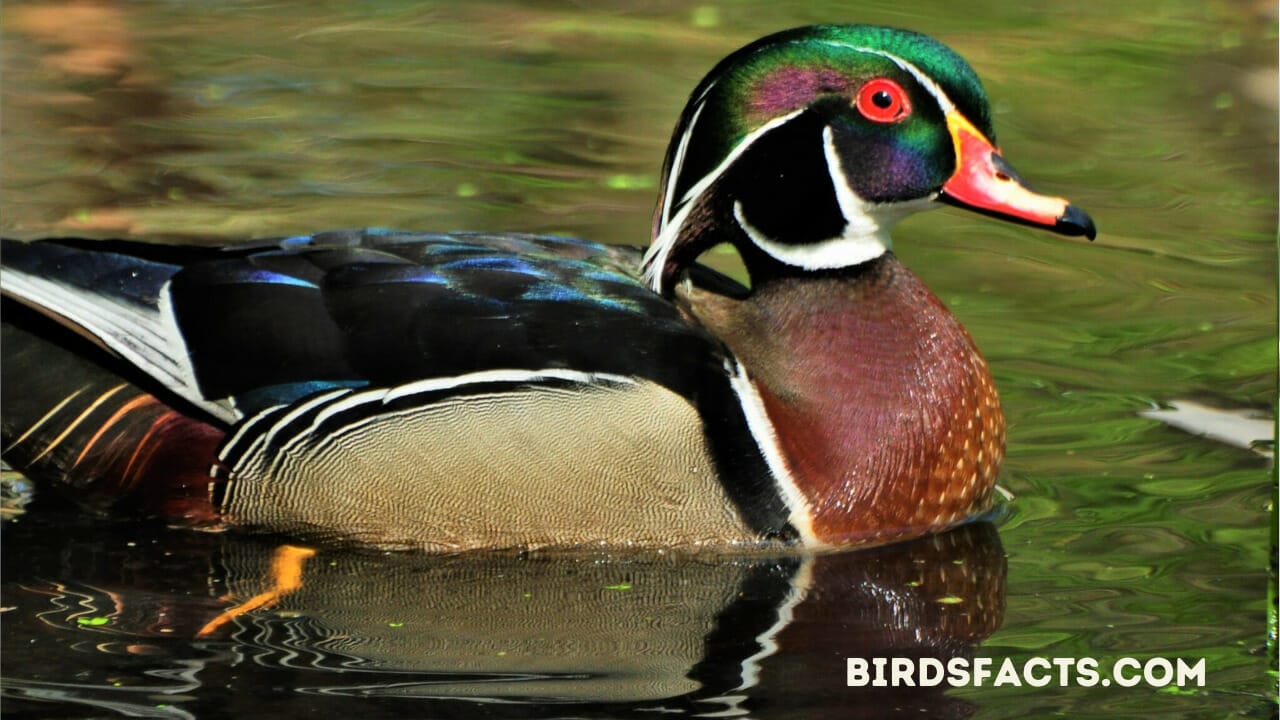
white bird with yellow mohawk
One of the most distinctive features of the Wood Duck is its colorful plumage, which is highly sought after for decoration and art purposes. The males of the species are particularly striking, with a colorful crest at the top of their heads, a metallic green head, and red eyes. In contrast, females have a more muted plumage with a distinctive white ring around their eyes. These ducks are also known for their unique nesting habits. They often use natural tree cavities near water sources as nesting sites, making them a common sight near ponds, rivers, and marshes.
Wood Ducks are also known for their unique flying abilities, with a wingspan of up to 30 inches and a top speed of 60 mph. They can also live for up to five years in the wild and molt their feathers yearly. Despite their colorful plumage, Wood Ducks are relatively small, with a length of around 19-21 inches and a weight of 1-1.5 pounds.
Overall, the Wood Duck is an important and beloved species in North America, with an estimated population of around 1.5 million birds. However, their population size is still considered vulnerable, and conservation efforts are needed to ensure their survival and protection for future generations.
| Attribute | Information |
|---|---|
| Common Name | Wood Duck |
| Scientific Name | Aix sponsa |
| Habitat | North America |
| Plumage | Vibrant, strikingly colorful with bold patterns and distinct colors |
| Diet | Omnivorous; feeds on various aquatic plants, small fish, invertebrates, and insects |
| Predators | Raccoons, snakes, predatory birds |
| Threats | Habitat alteration due to human activity |
| Distinctive Features | Colorful plumage, colorful crest (males), metallic green head (males), red eyes (males), white eye ring (females) |
| Nesting Habits | Use natural tree cavities near water sources for nesting |
| Flying Abilities | Wingspan up to 30 inches, top speed of 60 mph |
| Lifespan | Up to five years in the wild |
| Size | Length: 19-21 inches, Weight: 1-1.5 pounds |
| Population Size | Approximately 1.5 million birds |
| Conservation Status | Vulnerable |
| Importance | Important species in North America; requires conservation efforts for survival |
Eurasian Hoopoe
The Eurasian Hoopoe, with its scientific name Upupa epops, is a medium-sized bird that inhabits various regions across Asia, Europe, and Africa. With a wingspan of up to 44 cm and a length of approximately 28 cm, these birds are known for their distinctive features, such as their long, curved bill and a prominent feather crest on their head. The Hoopoe’s skin type is covered in brown, white, and black feathers.

white bird yellow mohawk
The bird’s diet mainly consists of insects, beetles, and small reptiles. They are cavity nesters and prefer nesting locations of holes or crevices in trees, walls, and rocks. Incubation time for their eggs is usually between 15-18 days, and the young birds molt at approximately two weeks of age. The lifespans of these birds average around 10 years, with a top speed during the flight of up to 60 km/h.
The Eurasian Hoopoe is also commonly known as the crown bird due to the distinctive feather crest on their head. The estimated population size of this bird is difficult to determine, but it is widely distributed throughout its range. However, their biggest threat is habitat loss due to deforestation and agricultural practices. Nonetheless, one fun fact about the Hoopoe is their unusual sound, resembling a ‘hoop-hoop-hoop’ sound which led to their name.
| Feature | Description |
|---|---|
| Scientific Name | Upupa epops |
| Size | Wingspan: Up to 44 cm<br> Length: Approximately 28 cm |
| Habitat | Various regions across Asia, Europe, and Africa |
| Distinctive Features | Long, curved bill<br> Prominent feather crest on the head |
| Skin Type | Covered in brown, white, and black feathers |
| Diet | Insects, beetles, and small reptiles |
| Nesting Behavior | Cavity nesters<br> Prefer holes or crevices in trees, walls, and rocks |
| Incubation Time | 15-18 days |
| Molting Age | Approximately two weeks |
| Lifespan | Average around 10 years |
| Top Speed | Up to 60 km/h during flight |
| Common Name | Eurasian Hoopoe |
| Alternative Name | Crown bird |
| Population Size | Difficult to determine, but widely distributed throughout its range |
| Threats | Habitat loss due to deforestation and agricultural practices |
| Fun Fact | Unusual sound resembling a ‘hoop-hoop-hoop’ sound, which led to their name |
Victoria Crowned Pigeon
The Victoria Crowned Pigeon, also known as the Goura victoria, is a stunning bird native to Indonesia and Papua New Guinea. This magnificent pigeon is one of the largest in the world, with a wingspan that can measure up to 2 feet in length. Its most distinctive feature is its unique crest, which resembles a crown and is composed of long blue feathers. The Victoriaigeon can weigh up to 7 pounds and measure up to 30 inches in length, making it a truly impressive bird.
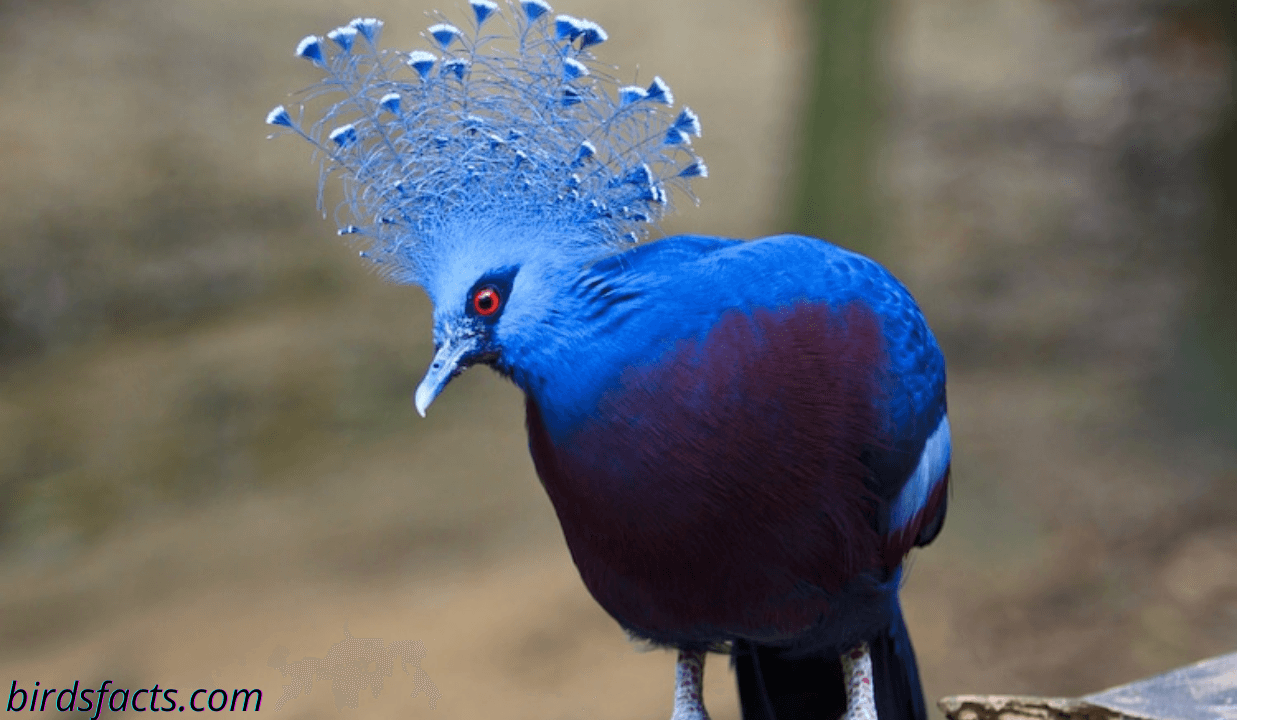
mohawk bird
These pigeons are generally found in lowland forests and prefer areas with dense undergrowth. They are herbivores and primarily feed on fruits, seeds, and insects. The Victoria Crowned Pigeon is monogamous and breeds throughout the year, with females laying only one egg in a nesting location on the ground. The incubation period for the egg is around 28 days, and the young pigeon is capable of molting at around two months of age.
Unfortunately, the biggest threat to the Victoria Crowned Pigeon’s survival is habitat loss due to deforestation. Their estimated population size is currently unknown, but it is believed to be further contributing so hunted for their meat and feathers, which has further contributed to their decline. Despite being threatened, the Victoria Crowned Pigeon is a fascinating bird with a fun fact: it has a top speed of up to 50 miles per hour! Overall, striking appearandeservencredible abilities make it a remarkable species that deserve our attention and protection.
| Feature | Description |
|---|---|
| Name | Victoria Crowned Pigeon |
| Scientific Name | Goura victoria |
| Native to | Indonesia and Papua New Guinea |
| Wingspan | Up to 2 feet |
| Crest | Resembles a crown, composed of long blue feathers |
| Weight | Up to 7 pounds |
| Length | Up to 30 inches |
| Habitat | Lowland forests with dense undergrowth |
| Diet | Herbivorous – primarily fruits, seeds, and insects |
| Reproduction | Monogamous breeding throughout the year; females lay one egg in a nesting location on the ground |
| Incubation Period | Approximately 28 days |
| Young Pigeon Molting Age | Around two months |
| Threats | Habitat loss due to deforestation, hunting for meat and feathers |
| Population Size | Currently unknown, but believed to be declining |
| Fun Fact | Top speed of up to 50 miles per hour |
Red-whiskered Bulbul
The Red-whiskered Bulbul, scientifically known as Pycnonotus jocosus, is a small passerine bird found in the tropical regions of Asia. They are commonly known for their vivid red patches on the sides of their face, which gives them their distinct name. The bird’s biggest threat is habitat loss due to deforestation and urbanization, despite having an estimated population size of around 20 million.
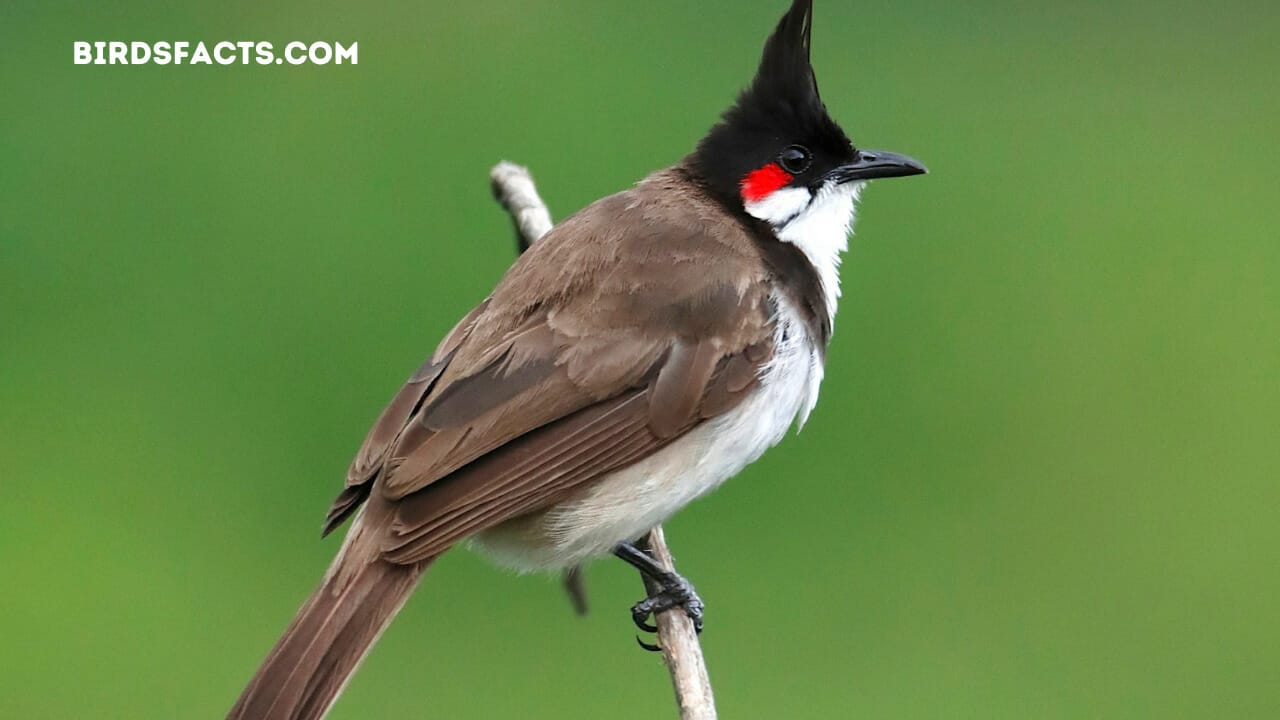
Red-whiskered Bulbul
These prey on insects, fruits, and nectar and can be found in various habitats, from suburban gardens to forest areas. Their most distinctive feature is their brightly colored plumage and the tuft of feathers on their heads extending to their cheeks. Sometimes they are also referred to as Crested Bulbuls due to this unique feature. Red-whislastsingspan is approximately 25cm, and their incubation period; is after around 14 days. They typically build their nests in trees, and the chicks filter 12 to 14 days after hatching.
Juveniles start molting at around 80 days, and the bird’s lifespan can last up to 11 years in the wild. Red-whiskered logically weigh around 20 to 35 grams and measure around 20cm in length. They are commonly found in India and tropical areas of Southeast Asia, the Philippines, and Indonesia. These birds have a soft, downy skin type and can reach top speeds of up to 23 mph. Overall, Red-whiskered Bulbuls are beautiful birds that add to the vibrant wildlife of the tropics.
| Species Name | Red-whiskered Bulbul |
|---|---|
| Scientific Name | Pycnonotus jocosus |
| Habitat | Tropical regions of Asia |
| Common Features | Vivid red patches on the sides of their face, tuft of feathers |
| Population Size | Approximately 20 million |
| Threats | Habitat loss due to deforestation and urbanization |
| Diet | Insects, fruits, and nectar |
| Habitat Range | Suburban gardens to forest areas |
| Wingspan | Approximately 25 cm |
| Incubation Period | Around 14 days |
| Nesting Behavior | Nests in trees |
| Chick Fledging Period | 12 to 14 days after hatching |
| Juvenile Molting | Starts at around 80 days |
| Lifespan (Wild) | Up to 11 years |
| Weight | 20 to 35 grams |
| Length | Approximately 20 cm |
| Geographic Range | India, Southeast Asia, the Philippines, Indonesia |
| Skin Type | Soft, downy |
| Top Speed | Up to 23 mph |
| Additional Notes | Adds to the vibrant wildlife of the tropics |
Golden Pheasant
The Golden Pheasant, scientifically known as Chrysolophus pictus, is a stunning bird inhabiting western China’s mountainous areas. These birds are primarily preyed upon by larger birds of prey and mammals such as foxes and wolves. With its vibrant color and long, beautiful tail feathers, this bird is known for its distinct and eye-catching appearance. The male Golden Pheasant is especially striking with its bright orange and yellow feathers, while the female is a more subdued brown.
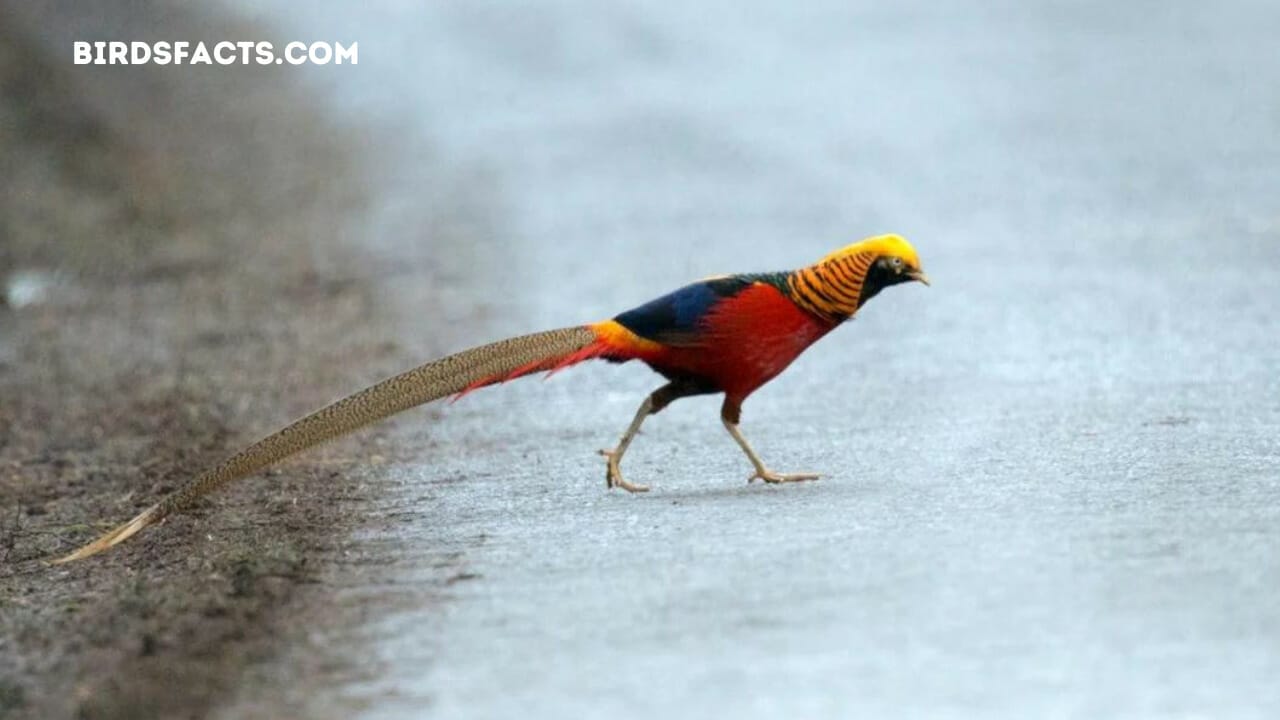
black bird with red mohawk
Incubation for eggs usually lasts around 22 to 24 days, and the birds can be found in various habitats ranging from forests to mountains. Their diet consists of seeds, fruit, insects, and small animals. The estimated population size of the Golden Pheasant is uncertain, but it is believed to be stable for now. However, habitat destruction and hunting pose the biggest threat to this species. The male wingspan can be up to 31 inches, while females have a shorter wingspan of 24 inches. These birds can live up to 15 years in captivity, but their lifespan in the wild may be shorter.
They can weigh up to 2.5 pounds and grow to 3 feet long. Molting occurs at around 10-12 months of age, and during this time, the bird’s colorful plumage is replaced by duller feathers. Known for its striking beauty and unique features, the Golden Pheasant is sometimes called the Chinese or rainbow pheasant. Overall, the Golden Pheasant is a fascinating and beautiful bird that continues to captivate bird enthusiasts worldwide.
| Attribute | Information |
|---|---|
| Scientific Name | Chrysolophus pictus |
| Common Name | Golden Pheasant |
| Habitat | Western China’s mountainous areas |
| Predators | Larger birds of prey, foxes, wolves |
| Appearance | Vibrant colors, long tail feathers |
| Male Colors | Bright orange and yellow |
| Female Colors | Subdued brown |
| Incubation Period | 22 to 24 days |
| Diet | Seeds, fruit, insects, small animals |
| Population Size | Uncertain, believed to be stable |
| Threats | Habitat destruction, hunting |
| Male Wingspan | Up to 31 inches |
| Female Wingspan | 24 inches |
| Captivity Lifespan | Up to 15 years |
| Wild Lifespan | Potentially shorter |
| Weight | Up to 2.5 pounds |
| Length | Up to 3 feet |
| Molting Age | 10-12 months |
Crested Tit
The Crested Tit, also known as Lophophanes cristatus, is a small bird in Europe and Asia. This bird species has a distinctive feature of black and white stripes running down its head, which looks like a miniature mohawk. The crest comprises feathers that can be raised or lowered depending on the bird’s mood or state of alertness. Crested Tits prefer living in coniferous forests, and woodlands with mature trees, and their diet is primarily based on insects, seeds, and small fruit. Crested Tits nest in tree holes or crevices and sometimes use artificial nesting boxes provided by humans. After an incubation period of about two weeks, the chicks hatch and fledge the nest after approximately three weeks.

Crested Tit
Despite being a small bird, the Crested Tit can reach a speed of 27 miles per hour. Their average lifespan is about three years, and they molt their feathers once a year, typically in the autumn. Although the population size of the Crested Tit is unknown, it is believed to be relatively stable. The biggest threat to this bird species is habitat loss due to deforestation and other human activities. With only one species of Crested Tit, this bird is similar in size to a blue tit, typically measuring around 11 centimeters in length and weighing approximately 9 grams.
The skin type of the Crested Tit is covered in feathers, typically grey or brown, with a distinctive crest of black and white stripes. Predators of the Crested Tit include birds of prey, snakes, and mammals such as mustelids. A fun fact about Crested Tits is that they store food in the winter, often hanging it in trees or under the bark to retrieve it when food is scarce. Further conservation efforts are necessary to protect the Crested Tit and ensure their survival for future generations.
| Species Name | Crested Tit |
|---|---|
| Scientific Name | Lophophanes cristatus |
| Size | Approximately 11 centimeters |
| Weight | Approximately 9 grams |
| Habitat | Coniferous forests, mature woodlands |
| Diet | Insects, seeds, small fruit |
| Nesting | Tree holes, crevices, artificial boxes |
| Incubation Period | About two weeks |
| Fledging Period | Approximately three weeks |
| Lifespan | About three years |
| Feathers | Grey or brown, black and white crest |
| Speed | Up to 27 miles per hour |
| Feeding Behavior | Stores food for winter |
| Predators | Birds of prey, snakes, mustelids |
| Threats | Habitat loss, deforestation |
| Population Status | Believed to be relatively stable |
| Conservation | Further conservation efforts needed |
Purple-crested Turaco
The Purple-crested Turaco, or Tauraco porphyreolophus, is a magnificent bird found in Africa’s lush forests. With its vibrant purple feathers and distinct purple crest, this bird stands out in its natural habitat. Its most distinctive feature is its large bill, which is perfect for its fruits, seeds, and insects diet. The Purple-crested Turaco is a medium-sized bird with a wingspan of around 18 inches and up to 20 inches long. These birds may be preyed upon by larger birds of prey and mammals such as snakes or primates. They typically live in pairs or small groups and can be found primarily in the forests of Angola, Tanzania, Kenya, and Zambia.

Purple-crested Turaco
The Purple-crested Turaco breeds in trees and lays two-three eggs per breeding season. Incubation typically takes around 21 days, with the young remaining in the nest for about a month before fledging. One interesting fact about these birds is that they molt just once a year, around eight months after their last molting cycle, at approximately two years of age.
Unfortunately, the biggest threat to the Purple-crested Turaco is habitat destruction due to deforestation and hunting for their colorful feathers. The estimated population size is unknown, but they are not considered endangered. The Purple-crested Turaco is also known as the Purple-crested Lourie.
Overall, the Purple-crested Turaco is a beautiful bird with a unique appearance and fascinating behavior. Its vibrant colors, large bill, and love for fruits and insects make it an important part of the African forests it inhabits. Measures must be taken to prevent further habitat destruction and hunting of this species so that future generations can appreciate their natural beauty.
| Species Name | Purple-crested Turaco |
|---|---|
| Scientific Name | Tauraco porphyreolophus |
| Habitat | Africa’s lush forests |
| Description | Magnificent bird with purple feathers and distinct purple crest. Medium-sized with a wingspan of around 18 inches and length of up to 20 inches. Large bill for fruits, seeds, and insects diet. Typically lives in pairs or small groups. |
| Distribution | Angola, Tanzania, Kenya, Zambia |
| Breeding | Breeds in trees. Lays 2-3 eggs per season. |
| Incubation Period | Approximately 21 days |
| Nestling Period | Around 1 month before fledging |
| Molting | Once a year, around 8 months after the last molting cycle, at approximately 2 years of age. |
| Predators | Larger birds of prey, snakes, primates |
| Threats | Habitat destruction, hunting for feathers |
| Conservation Status | Not considered endangered |
| Other Names | Purple-crested Lourie |
The Purple-crested Turaco is a beautiful bird that plays a crucial role in the African forests. It is important to protect its habitat and take measures against hunting to ensure its continued existence for future generations.
Sulphur-crested Cockatoo
The Sulphur-crested Cockatoo, scientific name Cacatua galerita, is a large and striking parrot native to Australia and nearby islands. Its most distinctive feature is its brilliant white feathers and bright yellow crest atop its head, which can be raised or flattened depending on its mood.

Sulphur-crested Cockatoo
They have a wingspan of up to 100cm and can grow up to 50cm long. Sulphur-crested Cockatoos are known to be highly social creatures and often found in flocks. They can be found in various habitats, including forests, woodlands, and urban areas. Their diet consists mainly of seeds, nuts, fruits, berries, and insects. The Sulphur-crested Cockatoo is among 21 cockatoo species and the largest among them. In Australia, their population is estimated to be around 180,000 individuals.
However, the biggest threat to their survival is habitat loss due to deforestation. Sulphur-crested Cockatoos also have a loud and distinctive call that can be heard from a great distance. They are known to mate for life and typically nest in tree cavities. Their incubation lasts about one month, and they usually begin molting at around two to three years of age. With a lifespan of up to 80 years, the Sulphur-crested Cockatoo is a long-lived bird with a strong presence in Australian wildlife.
| Information | Sulphur-crested Cockatoo |
|---|---|
| Scientific Name | Cacatua galerita |
| Native to | Australia and nearby islands |
| Size | Wingspan: up to 100cm<br>Length: up to 50cm |
| Appearance | Brilliant white feathers<br>Bright yellow crest |
| Habitat | Forests, woodlands, and urban areas |
| Diet | Seeds, nuts, fruits, berries, and insects |
| Social Behavior | Highly social creatures, often found in flocks |
| Population (Estimated) | Around 180,000 individuals in Australia |
| Threats | Habitat loss due to deforestation |
| Vocalization | Loud and distinctive call |
| Mating Behavior | Mate for life |
| Nesting Behavior | Nest in tree cavities |
| Incubation Period | Approximately one month |
| Age of Molting | Begins at around two to three years of age |
| Lifespan | Up to 80 years |
| Status in Australian Wildlife | Long-lived bird with a strong presence |
Conclusion
In conclusion, bird with mohawk are not only fascinating, but they also offer a glimpse into the incredible diversity of nature. From the colorful and flashy to the sleek and understated, these birds have a wide range of hairstyles that are as unique as the species. Whether you are a bird lover or appreciate the beauty of nature, taking the time to marvel at these amazing creatures is an experience you won’t soon forget. So, the next time you spot a bird with a striking hairstyle, take a moment to appreciate the wonder and beauty of the natural world.
FAQ
A bird in the northwest with a yellow mohawk?
A yellow mohawk on its head identifies one of the unique bird species found in the northwest region, and this striking characteristic sets it apart from other birds in the area. The bird is an intriguing sight and is admired for its distinctive appearance, and it is a reminder of the fascinating biodiversity present in the northwest region of the country.
A bird with a mohawk?
Imagine coming across a bird with a mohawk! This feathered creature would stand out among its peers. A mohawk is a distinct hairstyle; if a bird had one, it would be a unique and eye-catching sight. Not every day, you see unusual traits or features in animals, so encountering a bird with a mohawk would be a special experience.
What is the bird with a mohawk called?
The bird with a mohawk is known as the Crested Auklet. This quirky little bird is found in the North Pacific, particularly in Alaska, Russia, and Japan. The Crested Auklet gets its name from the distinctive feathers on its head, which stick up like a mohawk hairstyle. This unique look is part of the bird’s courtship displays and helps them attract a mate during the breeding season.
What big bird has a mohawk?
What big bird has a mohawk? The answer is the southern cassowary, a flightless bird found in Australia and Papua New Guinea. Its distinctive mohawk-like feathers are black and occur on the top of its head. These birds can grow up to 6 feet tall and weigh over 130 pounds. The cassowary is known for its powerful kick and aggressive behavior, making it one of the most dangerous birds in the world.
What animal has a mohawk?
The animal that has a mohawk is a porcupine! Their quills, which cover their back and sides, stand up straight to create a mohawk-like appearance when they feel threatened. The porcupine’s unique defense mechanism makes them less vulnerable to predators and gives them a punk rock look.
Further Reading
You may also check out:
- 10 Birds You Can Find In the Desert
- Bird with Red Beak
- Long Neck Bird
- Yellow Birds In Michigan
- Phoneboard
Thank you for reading!



